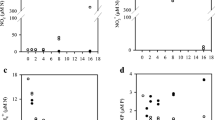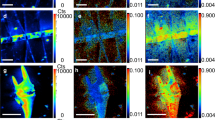Abstract
The flux of newly photosynthetically fixed, dissolved organic carbon (PDOC) from phototrophs to microheterotrophs in Lake Kinneret was examined by differential (3 and 0.4μm) filtration after samples were incubated with14C-bicarbonate for 3 hours (in the light) and subsequently for 21 hours (in darkness). Only a small proportion (average about 10%) of the carbon fixed from14C-bicarbonate in the light was associated with particulate matter <3μm. In 14 out of 16 experiments there was no significant decrease in the relative proportion of radioactivity associated with larger (>3μm) organisms after the dark period, suggesting that the amount of PDOC taken up by unclumped, single bacteria (<3μm) was not very great. Respiration rates, estimated by the decrease in14C particulate counts in the dark period, ranged from 3.4 to 21.2% of daylight net photosynthesis. In almost all cases, parallel experiments with additions of radioactive glucose or amino acids indicated that the majority of active heterotrophs passed through 3μm filters. Apparent residence times for glucose and amino acids were 20 to 168 hours and 20 to 152 hours, respectively.
Similar content being viewed by others
References
Allen, H. L.: Production and utilization of dissolved organic carbon during insitu phytoplankton photosynthesis measurements. Int. Rev. Ges. Hydrobiol.58(6); 843–849 (1973)
Anderson, G. C. and R. P. Zeutschel: Release of dissolved organic matter by marine phytoplankton in coastal and offshore areas of the Northeast Pacific Ocean. Limnol. Oceanogr.15, 402–407 (1970)
Azam, F. and R. E. Hodson: Size distribution and activity of marine microheterotrophs. Limnol. Occanogr.22, 492–501 (1977)
Berman, T.: Size fractionation of natural aquatic populations associated with autotrophic and heterotrophic carbon uptake. Mar. Biol.3, 215–220 (1975)
Berman, T.: Release of dissolved organic matter by photosynthesizing algae in Lake Kinneret, Israel. Freshwater Biol.6, 13–18 (1976)
Berman, T., O. Hadass, and U. Marchaim: Heterotrophic glucose uptake and respiration in Lake Kinneret. Hydrobiol.62(3), 275–282 (1979)
Berman, T. and U. Pollingher: Annual and seasonal variations of phytoplankton, chlorophyll and photosynthesis in Lake Kinneret. Limnol. Oceanogr.19, 31–55 (1974)
Berman, T. and M. Stiller: Simultaneous measurement of phosphorus and carbon uptake in Lake Kinneret. Microbial. Ecol.3, 279–299 (1977)
Cavari, B. Z., and O. Hadass: Heterotrophic activity, glucose uptake and primary productivity in Lake Kinneret. Freshwater Biol.9, 329–338 (1979)
Chang, W. H. and W. E. Tolbert: Excretion of glycollate, mesotartrate, isocitrate and lactose by synchronized cultures ofAnkistrodesmus braunnii. Plant Physiol.46, 377–385. (1970)
Chrost, R. J.: The estimation of extracellular release by phytoplankton and heterotrophic activity of aquatic bacteria. Acta Microbiol. Pol.27, 139–146 (1978)
Coveney, M. F., G. Cronberg, M. Enell, K. Larsson, and L. Olfsson: Phytoplankton, zooplankton and bacteria—standing crop and production relationships in a eutrophic lake. Oikos29, 5–21 (1977)
Derenbach, J. B., and P. L. LeB. Williams: Autotrophic and bacterial production: fractionation of plankton populations by differential filtration of samples from the English Channel. Mar. Biol.25, 263–269 (1974)
Eppley, R. W., and J. H. Sharp: Photosynthetic measurements in the central North Pacific: The dark loss of carbon in 24-h incubations. Limnol. Oceanogr.20(6), 981–987 (1975)
Fogg, G. E.: Extracellular products of phytoplankton and the estimation of primary productivity. Rapp. P. V. Reun., Cons. Int. Explor. Mer.144, 56–60 (1958)
Fogg, G. E., C. Nalewajko, and W. D. Watt: Extracellular products of phytoplankton photosynthesis. Proc. R. Soc. Lond. [Biol.],162, 517–534 (1965)
Gophen, M.: Zooplankton in Lake Kinneret. In C. Serruya (ed.): Lake Kinneret, Monographiae Biologicae. W. Junk b.v. Publishers, The Hague (1978)
Hagstrom, A., U. Larsson, P. Horstedt, and S. Normark: Frequency of dividing cells, a new approach to the determination of bacterial growth rates in aquatic environments. Appl. Environ. Microbiol.37(5), 805–812 (1979)
Hellebust, J. A.: Extracellular products, In W. D. Stewart (ed.): Algal Physiology and Biochemistry, pp. 838–868. University of California, Los Angeles (1974)
Höppe, H. G.: Determination and properties of actively metabolising heterotrophic bacteria in the sea, investigated by means of microautoradiography. Mar. Biol.36, 291–302.
Iturriaga, R., and H. G. Höppe: Observations of heterotrophic activity on photoassimilated organic matter. Mar. Biol.40, 101–108 (1977)
Keating, K. I.: Allelopathic influence on blue-green bloom sequence in a eutrophic lake. Science196, 885–887 (1977)
Larsson, U., and A. Hagstrom: Phytoplankton exudate release as an energy source for the growth of pelagic bacteria. Mar. Biol.52, 199–206 (1979)
Lee, K., and C. Nalewajko: Photosynthesis, extracellular release and glycollic acid uptake by plankton: fractionation studies. Verh. Int. Verein. Limnol.20, 257–262 (1978)
Leppard, G. G., A. Massalski, and D. R. S. Lean: Electron-opaque microscopic fibrils in lakes: their demonstration, their biological derivation and their potential significance in the redistribution of cations. Protoplasma92, 289–309 (1977)
Massalski, A., and G. G. Leppard: Morphological examination of fibrillar colloids associated with algae and bacteria in lakes. J. Fish. Res. Board Can.36, 922–938 (1979)
Overbeck, J.: Distribution pattern of uptake kinetic responses in a stratified eutrophic lake (Plussee ecosystem study IV). Ver. Int. Ver. Limnol.19, 2600–2615 (1975)
Paerl, H. W., and D. R. S. Lean: Visual observations of phosphorus movement between algae, bacteria, and abiotic particles in lake waters. J. Fish. Res. Board Can.33(12), 2805–2813 (1976)
Pollingher, U., and T. Berman: Autoradiographic screening for potential heterotrophs and estimation of relative phototrophic activity of natural phytoplankton populations in Lake Kinneret. Microbial Ecol.2, 252–260 (1976)
Pollingher, U., and T. Berman: Quantitative and qualitative changes in the phytoplankton in Lake Kinneret, Israel, 1972–1975. Oikos29, 418–428 (1978)
Pomeroy, L. R.: Residence time of dissolved phosphate in natural waters. Science131, 1731–1732 (1960)
Pomeroy, L. R.: Secondary production mechanisms of continental shelf communities. In R. J. Livingston (ed.): Ecological Processes in Coastal and Marine Systems. Plenum Publ. Corp., New York (1979)
Saunders, G. W., Jr.: The kinetics of extracellular release of soluble organic matter by plankton. Verh. Int. Verein. Limnol.18, 140–146 (1972)
Serruya, C. (ed.): Lake Kinneret, Monographiae Biologicae. W. Junk b.v. Publishers, The Hague (1978)
Sharp, J. H.: Excretion of organic matter by marine phytoplankton: do healthy cells do it? Limnol. Oceanogr.22(3), 381–399 (1977)
Sieburth, J. McN.: International Heligoland Symposium: Conveners' Report on Biomass and Productivity of Microorganisms in Planktonic Ecosystems. Helgolander wiss Meersunters,30, 697–704 (1977)
Smith, W. O., Jr., R. T. Barber, and S. A. Huntsman: Primary production off the coast of northwest Africa: excretion of dissolved organic matter and its heterotrophic uptake. Water Res.24, 35–47, (1977)
Thomas, J. P.: Release of dissolved organic matter from natural populations of marine phytoplankton. Mar. Biol.11, 311–323 (1971)
Waterbury, J. B., S. W. Watson, R. R. L. Guillard, and L. E. Brand: Widespread occurrence of a unicellular marine planktonic cyanobacterium. Nature277, 293–294 (1979)
Watt, W. D.: Release of dissolved organic material from the cells of phytoplankton populations. Proc. R. Soc. Lond. [Biol.],164, 521–551 (1966)
Wetzcl, R. C.: Limnology. W. B. Saunders. Co. Philadelphia (1975)
Wiebe, W. J., and D. F. Smith: Direct measurement of dissolved organic carbon release by phytoplankton and incorporation by microheterotrophs. Mar. Biol.42, 213–223 (1977)
Author information
Authors and Affiliations
Rights and permissions
About this article
Cite this article
Berman, T., Gerber, C. Differential filtration studies of carbon flux from living algae to microheterotrophs, microplankton size distribution and respiration in Lake Kinneret. Microb Ecol 6, 189–198 (1980). https://doi.org/10.1007/BF02010384
Issue Date:
DOI: https://doi.org/10.1007/BF02010384




